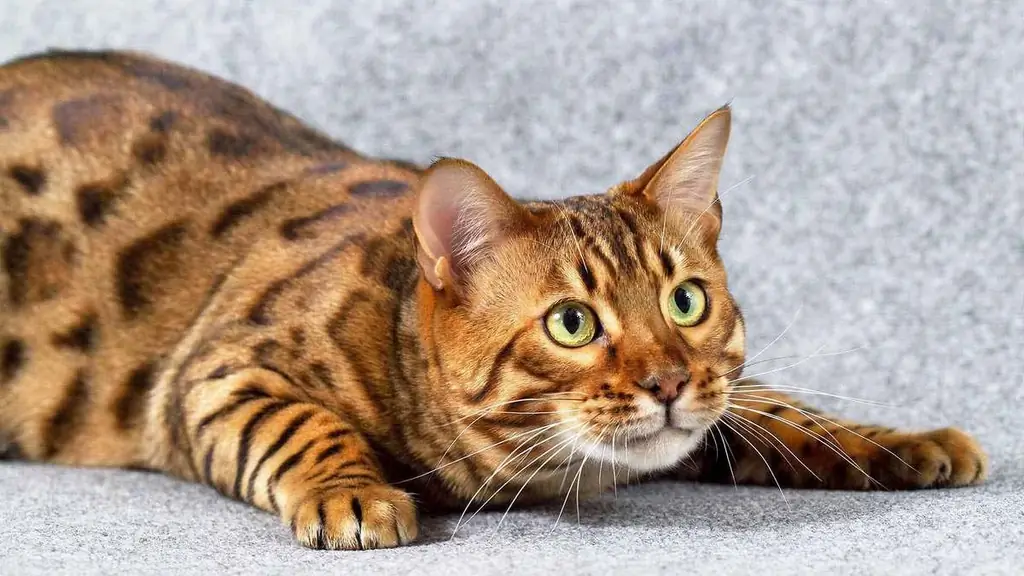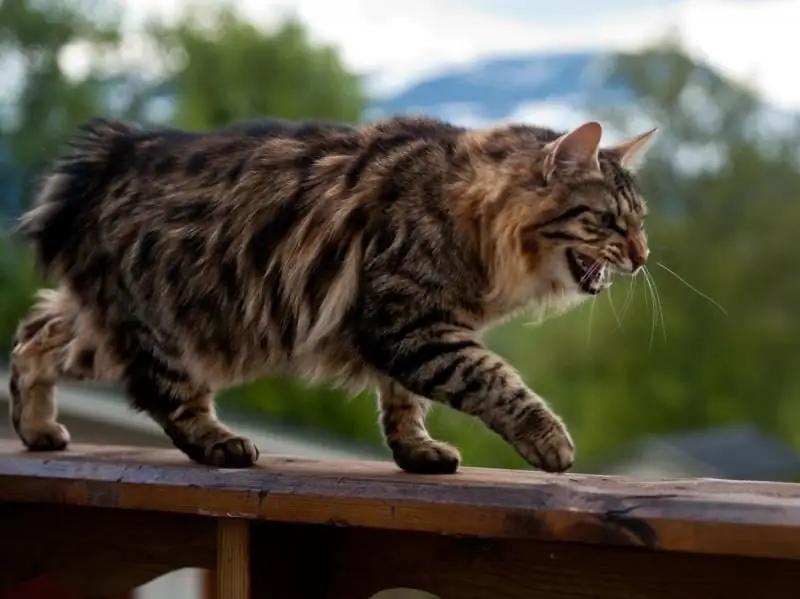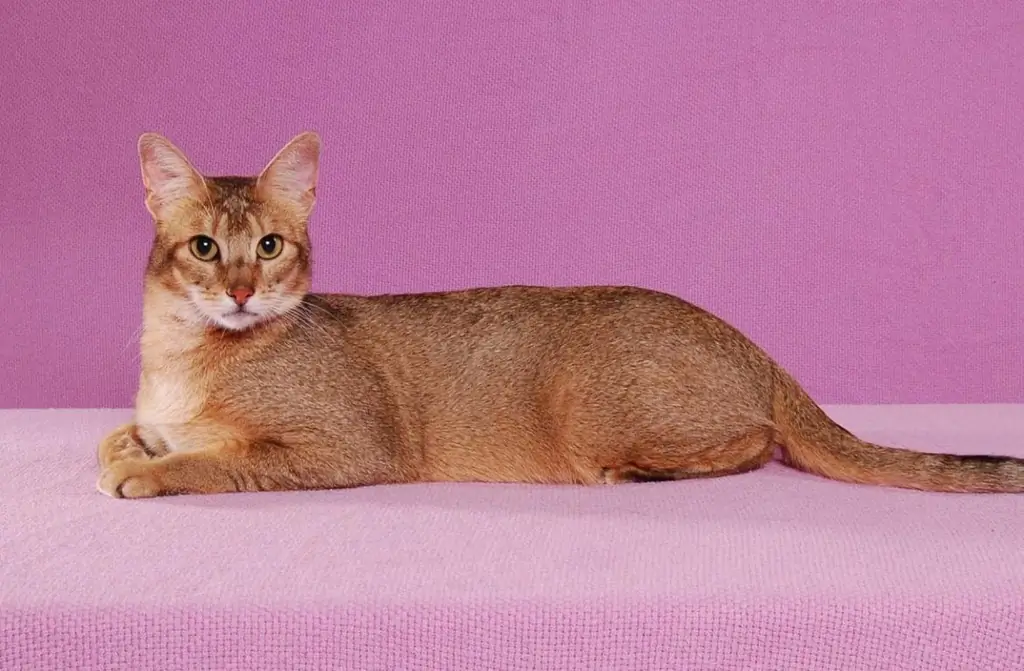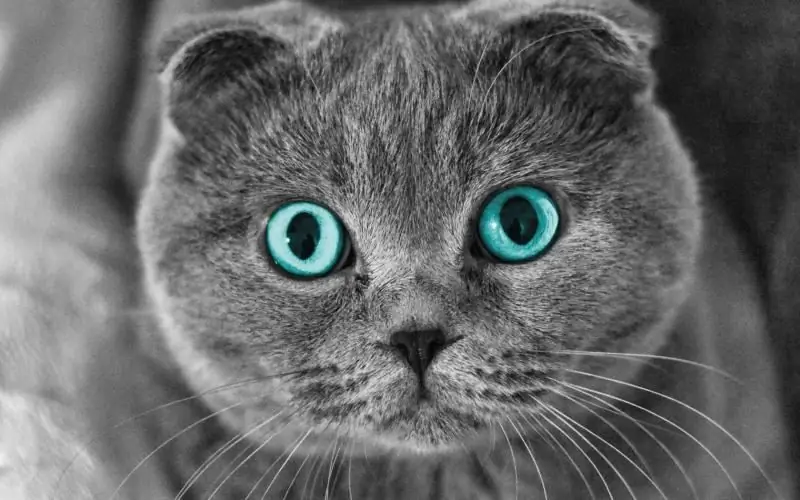
Table of contents:
- Author Bailey Albertson [email protected].
- Public 2024-01-17 22:26.
- Last modified 2025-06-01 07:32.
Fluffy princess of Persia - Persian cat

The Persian cat is a fluffy beauty with a flattened face popular among cat lovers. It is simply impossible to pass by such a cat. And its numerous color variations will please any, even the most demanding owner.
Content
- 1 History of Persian cats
-
2 Description of appearance
- 2.1 Table: the most common colors of Persians
- 2.2 Photo gallery: varieties of Persian cats
- 3 Character
- 4 Health
-
5 Care features
- 5.1 Video: how to clean a cat's ears
- 5.2 Nutrition
- 5.3 Organization of the toilet
- 6 How to choose a Persian kitten
- 7 Breeding
- 8 Castration and sterilization of the Persians
- 9 Video: Persian cats
- 10 Host reviews about Persian cats
History of Persian cats
Controversy constantly arises around the history of the origin of the Persian cat. According to one theory, it was imported from Persia. And adherents of the other argue that the homeland of the Persians is Russia, because the representatives of the breed have a long warm coat, which means that their living conditions should be very different from the Asian climate. From this they conclude that the Persians originally lived on the territory of Russia, from where they later came to the East, and then to Europe.

According to one version, Pallas' cat is the ancestor of Persian cats
More reliable information about the appearance of Persian cats in Europe dates back to the 17th century. Aristocrat and traveler Pietro de la Valle, while in Italy, was so delighted with these fluffy beauties that he sent several animals to the Pope. He also wrote about the charms of the Persian cat breed to his friend, the French diplomat de Peiriche, which interested him very much. There is a version that the first breeder of these cats was Cardinal Richelieu himself, who was a friend of de Peiriche, thanks to him Persian cats became very popular.

When the Persian cat was introduced to Europe, it was often confused with the Angora breed.
Later in the UK, at the 1871 exhibition, Persian pussies firmly won their place in the hearts of cat lovers. The breed standard was described in 1889. And when they got to America in the 19th century, Persian cats acquired a modern appearance with a characteristic flattened muzzle. The breeders liked the unusual and touching appearance of such cats, but such changes in the structure of the skull also caused health problems: shortness of breath and increased tearing. It took a lot of time and effort to breed a healthy breed.
Description of appearance
Currently, the breed standard recognizes 3 types of Persian cats, which differ in the features of the muzzle:
-
Classic or British. It is now deprecated. Outwardly, these cats resemble ordinary ones. Their muzzle is not so flat, and their nose is slightly below eye level.

British persian cat The nose of the British-style Persian cat is located just below the eyes
-
Modern, or short-nosed. In Persians of this variety, the upper part of the nose and the lower part of the eyes are almost at the same level.

Short-nosed persian cat The short-nosed Persian cat has a neat nose, located almost at the level of the inner corners of the eyes
-
Extreme, or American. The upturned nose is very high, almost at the corner of the eyes.

American Persian cat A characteristic feature of the American Persian cat is a highly lifted nose
There is also an overly extreme type of Persian cat, which is also called the pickface. These individuals are distinguished by the highest possible position of the nose (above the corners of the eyes), which is strongly flattened. Such animals are currently banned by almost all cat associations, as they lay an unhealthy gene pool of the breed.
The rest of the characteristic features of the Persians are the same for all types. These include:
- strong physique;
- long, silky wool up to 12 cm in length on the chest forms a fluffy collar, on the hind legs - fur "pants";
- large rounded eyes, located quite far from each other;
- the head is round, rather large;
- ears are small, densely covered with wool, slightly rounded at the tips;
- the tail is short, fluffy, the tip is rounded, directed downward;
- paws are short, strong.
Cats can weigh up to 7 kg and cats up to 4-5 kg. Height at the withers - up to 30 cm.
The color of Persian cats is presented in hundreds of colors. At exhibitions, all colors are divided into 5 groups:
- one-color type of color;
- smoky tabby;
- shaded;
- partially painted;
- the coloring is limited to the colors of the points (spots).
Table: the most common colors of Persians
| Color | Description | Eyes |
| The black | Any other color on the coat will be disqualified. Only gray undercoat allowed. | The color of the eyes of these cats is orange. |
| Color point | The literal translation of this phrase from the English language means "colored dot". Persians of this type have a cream-colored or ivory-colored torso, and some of its parts (paws, tail, ears and muzzle) are marked with darker shades of wool. | Blue eyes. |
| White | The color of this representative is pure white. Any inclusions are not allowed. | The eyes can be blue or orange. |
| Blue | This color is a light gray shade with a strong blue tint. | The eyes of these cats are usually yellow or orange. |
| Cream | Differs in honey or pale-cream color. Inclusions of any other colors are not allowed. | Copper-colored eyes. |
| Chinchilla | The coat of these cats is white, smoky-silver or apricot. At the ends of the hair it has a black or dark brown tint. | Green eyes. |
| Tabby | This term means the unusual color of the cat, which is a pattern on the coat. Cats of this type can be silver, red, brown, as well as cream, blue, purple, tortoiseshell. | The eyes can be copper-colored, green or brown. |
| Tortoiseshell | The amazing color of this type of cats is created by spots of various shades: cream, black, red, purple, chocolate, blue. The spots on the body should be evenly distributed. | Copper eyes. |
| Pewter | This cat is also called pewter. The color is a white background with dark shadows on the limbs and back. | The eyes can be orange or coppery. |
Felinologists (cat specialists) divide Persian cats not by color, but by eye color. The following shades are distinguished:
-
yellow - cats with this eye color, in turn, are divided into individuals with a simple coat color and complex:
- simple is characterized by the same color of the main hair and undercoat, this color is represented by white, red, black and tortoiseshell Persians;
- complex color is wool, in which the undercoat is lighter, such a skin is, for example, in smoky Persians;
- green - cats with this eye color cannot have a simple color, only complex colors are possible, for example, the Persian chinchilla cat belongs to such;
- blue - cats with such eyes are distinguished by bright markings on a lighter coat, these include color-point Persian cats.
Photo gallery: varieties of Persian cats
-

Chinchilla persian cat - Perhaps the chinchilla has the most artistic appearance among Persian cats.
-

Color-point persian cat - Color-point cats have dark tan marks of various shades on a light background
-

White persian cat - White Persians in color are not allowed any extraneous shades.
-

Black Persian - Black Persians have a gray undercoat.
Exotic short-haired individuals originated from ordinary long-haired cats. They appeared as a result of crossing the Persians with the American Shorthair cats. The result is a kitty with a characteristic Persian face, behavior and character, but with short hair. The variety of colors of this species is also in the tens.

Persian shorthair cat differs from its counterparts only in the length of the coat
Character
Persians are absolutely domestic cats. Representatives of this breed are very attached to humans. They get along well with children, endure the gripping and clumsy stroking of babies with honor. The Persian cat singles out the owner, in whose absence it can be very worried: refuse to take food and water, sit and lie in one place until he comes. She is very hard to endure loneliness and can even walk on the heels of the owner, annoying him with the fact that she constantly "gets underfoot."
The Persian cat takes great care of its offspring. At the same time, she allows the owner to participate in caring for the babies. By temperament, Persians are both mobile and calm, but aggressive are very rare. Kittens and young cats are quite playful. If you play with them, then this playfulness can be maintained throughout the pet's life.
Other pets are treated well. Persians do not take small rodents and birds for their prey, so they peacefully coexist with each other.

Persians get along well even with rodents and birds
At first, guests may be avoided, but in general they are friendly towards strangers.
There are rumors about Persian cats that they are supposedly extremely quarrelsome with humans, vindictive, stupid and lazy. But this is absolutely not the case. The Persian lived in our house for over 12 years. This handsome man was very smart. It is strange to hear about a cat, but every day he met his husband, whom he recognized as the owner, at the doorstep, like a dog. He got along well with a small child. He never scratched the baby, although in his place another cat would have already got tired of the constant tugging at the tail.
Health
Persian cats are considered to be representatives of a relatively healthy breed. But there are several diseases that are most often found in them:
- Polycystic kidney disease (formation and growth of cysts in the kidneys). This hereditary disease, which manifests itself at the age of 3-10 years, is detected by ultrasound examination. There is no specific treatment for this genetically determined disease, the disease will develop and lead to the death of the animal. However, it is possible to somewhat slow down the course of the disease by adhering to a special diet aimed at constant replenishment of proteins, electrolytes and fluids washed out by the affected kidneys.
- Progressive retinal atrophy is a hereditary disease that manifests itself by 4-8 weeks, after a few months the animal becomes completely blind. Characteristic changes in the retina and other parts of the eye can be detected with an ophthalmologic examination by a veterinarian. There is currently no cure.
- Excessive tearfulness of the eyes associated with a flat muzzle: the lacrimal canal in the Persians is curved, and large bulging eyes and long hair contribute to constant irritation of the cornea and lacrimation. There is no treatment, you need to regularly carry out hygiene procedures.
-
Hypertrophic cardiomyopathy (thickening of the ventricular wall). Examination and treatment are required. If at least one of the symptoms occurs, you need to see a doctor. The main symptoms are:
- depression of the animal;
- heavy breathing, accompanied by wheezing or even “gurgling”;
- dyspnea;
- tachycardia;
- the mucous membranes become bluish;
- thromboembolism (in most cases one pelvic limb fails, occasionally both);
- heart murmurs;
- pulmonary edema;
- accumulation of fluid in the chest cavity (hydrothorax);
- high blood pressure;
- fainting.
The average life span of the Persians is about 15 years
Care features
The Persian cat needs daily grooming. Therefore, if there is no opportunity to devote a little time to the pet every day, then it is better not to have such a cat. The main duty of the owner of the Persian is the daily brushing of the pet's thick coat. You need to comb the animal daily, preferably even 2 times a day, to prevent the wool from rolling into tangles.

Caring for a Persian cat is simple, the main thing is to observe regularity
Caring for the hair of a Persian cat should take place in several stages:
- combing with a comb with rare teeth;
- using a comb with an average distance between the teeth;
- smoothing hairs with a fine-toothed brush.
You can use special care products for your pet's fur coat - conditioner or spray.
Once a month, the animal should be bathed with a special shampoo for long-haired cats
The features of the structure of the muzzle lead to the fact that often the eyes of a Persian cat are watery. Therefore, when discharge from the eyes appears, wipe them with a cotton pad moistened with saline or water. Since Persians are at risk of eye lacrimation, the veterinarian may advise the use of special cat eye lotions for prophylactic purposes.
At intervals of 1-2 times a week, your pet needs to clean its ears.
Brushing your cat's teeth is equally important to prevent the formation of gingivitis and tartar, which can cause serious illness. This procedure should be done 1-2 times a week.
Video: how to clean a cat's ears
Food
There are usually no special problems with feeding Persian cats. They are practically omnivorous. In the diet, you can use both ready-made commercial feeds and natural products. Feeding a cat with ready-made food is more convenient: some manufacturers have even developed products specifically for Persians (for example, Royal Canin Adult Persian).

Many manufacturers offer special food for Persian cats.
Suitable foods for Persian cats are:
- Orijen Cat 6 Fresh Fish 2014;
- Golden Eagle Holistic Adult Cat 32/21;
- Bosch Sanabelle Hair & Skin for Cats;
- Purina Pro Plan Delicate;
- Royal Canin Persian.
It is best to check with your veterinarian to recommend the right food for your cat. Fluffy may be allergic to some dry foods. It is important not to forget that you cannot mix natural food with commercial food: this can seriously harm the cat's digestion.
Balance is important when choosing natural products. The diet must include:
- proteins, the amount of which should be almost 50% of the diet (lean meat, fish, dairy products);
- carbohydrates (cereals, vegetables and fruits);
- fats (vegetable oil).

The diet of Persian cats must be balanced
The list of prohibited foods includes:
- all cooked human food;
- salty, fried, smoked, sweet food;
- pork, lamb;
- goose, duck;
- spleen, chicken necks and bones;
- seafood;
- cream, sour cream, butter, salted cheese;
- citruses, kiwi, pineapple;
- persimmon;
- rhubarb;
- nuts;
- beans;
- potatoes, broccoli;
- onion garlic;
- tomatoes, eggplants;
- mushrooms;
- chocolate;
- Tea coffee;
- alcohol;
- bread and other pastries.
Persian cats are prone to overeating and, as a result, obesity. Therefore, it is very important not to overfeed your pet. You need to feed an adult Persian cat 2 times a day. Kittens eat more often, until they reach 6 months of age they are fed 5-6 times a day. In six months, the number of feedings is reduced to 3-4 times. You can switch to two meals a year.
Organization of the toilet
Persian cats are easy to train, so usually there are no problems with litter training. Having brought a Persian kitten to the house, the first step is to determine a permanent place for the toilet. The tray should be fairly large with high sides.
It is advisable to use special cat litter. You can, of course, just choose a tray with a mesh or fill it with sand or newspaper, but in this case, the smell cannot be avoided. When choosing the right filler, you should focus on the pet's behavior. Persian cats are quite finicky in this matter. Having chosen the place of the toilet and the filler for it, it is undesirable to change them later.
How to choose a Persian kitten
It is recommended to buy an animal from nurseries, exhibitions or special clubs.
When choosing a baby of the Persian breed, you should adhere to the basic recommendations:
- The characteristics of the breed are clearly manifested in the Persians at the age of 3-4 months. Therefore, this is the best period for acquiring a kitten.
-
The muzzle should be symmetrical and characteristic of the pets of this breed: a raised and flattened nose is the first sign of pedigree.

Persian kitten When choosing a kitten, you need to carefully examine it: it must have breed characteristics, be curious and clean
- The kitten should be playful and curious.
- The eyes and ears should be clean and free of discharge.
- The coat should be smooth, the skin should be clean.
- Boys should have both testicles descended.
- There should be no creases on the tail.
- The kitten should not shake its head, sneeze or cough.
- The abdomen should not be swollen.
- The anal opening should be clean and dry, without redness.
When choosing the sex of your pet, first of all you need to answer yourself the question of what goal you are pursuing. If you plan to breed and receive income from the sale of kittens, then you need to take a female. If performance at exhibitions is a priority, then cats usually win. If you just buy a pet, then choose a female: usually cats are more affectionate and obedient. You also need to remember that females are usually more expensive than males.

The price of a kitten depends on the pedigree, place of purchase and gender
Breeding
The optimal age for mating is 16-20 months. The cat is ready to mate at the age of one. The most important thing in the mating process is to choose a cat with a good genealogy.
Pregnancy of Persian cats lasts 63-66 days. It is possible to deviate from the norm by 4-7 days, both in the direction of increasing the term, and in the direction of decreasing it. Pregnancy usually passes without complications, but during this period it is important to pay increased attention to your pet. It is important to prepare a comfortable place for the cat before giving birth.
Castration and sterilization of the Persians
Contrary to popular belief that neutering only applies to cats and neutering to cats, these operations can be performed on animals of both sexes.
Despite this, veterinarians have conventionally determined that the term "castration" refers to males, and "neuter" refers to cats. During the operation, the testes are removed from cats, and from a cat - the ovaries or ovaries along with the uterus.
The best time for castration is 6-8 months of age. It is optimal to neuter a cat between the ages of 9 and 12 months. After the operation, the animal will need to be closely monitored:
- The animal should be placed in a warm place on a mat.
- The cat will need to place a bowl of water and a litter box next to the bedding.
- While the animal is recovering from anesthesia, it will be disoriented, so you need to make sure that the cat does not climb on high surfaces.
- You need to feed your pet 8 hours after the operation.
- In cats, it will be necessary to monitor the condition of the seam.

To prevent the cat from reaching the seam, a special blanket is put on it
Video: Persian cats
Host reviews about Persian cats
The Persian cat rightfully occupies a leading position among pets. Such a beautiful appearance, like that of the Persians, deserves the care that the owner should provide for her. And in order for the cat to live as long as possible, you should adhere to the recommendations of the veterinarian and follow the advice on care and maintenance.
Recommended:
Bengal Cat: Description Of The Breed, Character And Habits, Photos, How To Choose A Kitten, Reviews Of The Owners Of A Home Bengal

The origin of Bengal cats. External description of the breed. Features of the acquisition. The character and behavior of Bengals. The specifics of caring for a Bengal cat. Reviews
Kurilian Bobtail: Photo, Description Of The Breed, Character And Behavior Of The Cat, Reviews Of The Owners Of The Cat, The Choice Of A Kitten

The history of the Kurilian bobtail. Description of the breed. The nature and behavior of Kuril cats. Diseases of the breed. Buying a kitten breed. Care and hygiene. Breeding. Reviews
Chausie: Description Of The Breed, Character And Habits Of A Houseie Cat, Photo, Choice Of A Kitten, Reviews Of Cat Owners

The history of the origin of Chausie. Breed standard. Character, behavior, health. Features of nutrition. Tips for choosing a Chausie kitten. How to breed. Reviews. Video
Scottish Fold Cat: Character, Description Of The Breed, How To Feed, How To Choose A Kitten, Photo, How To Name A Scotsman

The history of the breed. What does a lop-eared cat look like? Character, behavior and diseases of the breed. Features of the care of the Scottish Fold cat. Reviews
Peterbald (St. Petersburg Sphynx): Description Of The Breed, Photo, Character And Content Of The Cat, Reviews Of The Owners

Where the breed was bred. What are the main external differences, what character it has. How to properly care for the breed, feed. How to choose a kitten
